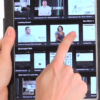Attention marketers, we’re here to help! In today’s ever-changing digital environment, marketers and advertisers are hard pressed to stay on top of the “latest trends.” Successful marketers are agile creatives that continually adapt their strategies, always one step ahead of the next great idea. Sparksight is here with the low down on VR and why it’s on the cover of every magazine. Ready, set, GO!
It’s no secret that VR is taking off. Unlike other technologies that have come before it, VR is an almost-too-real and highly-immersive experience that tricks the mind into thinking what it’s experiencing is real.
So, What is VR?
Virtual reality (VR) is a computer-generated environment that lets the viewer experience a different reality. A VR headset fits around your head and over your eyes, and visually separates you from whatever space you’re physically occupying.
Why is it Important for Marketers/Advertisers?
One of the most compelling aspects of virtual reality is its power to transport viewers to a place they could not or would not go. Virtual reality puts the viewer at the center of the story. If it’s done well, it creates a feeling of presence. It allows people to experience real-time events and feel connected to the experience. VR also offers unique features for data that allow advertisers to track eye movements in order to know exactly what parts of the screen viewers are looking at and the parts they’ve chosen to interact with.
To Watch and Finish an Ad
Besides providing compelling content that someone likely wants to watch, virtual reality provides a captive audience. A user might normally try to escape mobile video advertising, but if they have a VR headset on, it’s probably there to stay. While VR presents a unique opportunity for advertisers to reach a completely immersed audience, it also means they must create ads that people don’t mind watching or interacting with.
There’s a lot of $$$ in VR
Big companies like Facebook, Google, PlayStation and Samsung all either have plans for VR headsets, or already have a version out. These headsets range anywhere from the $20 to $800, so even though it could be expensive to get started, it’s hard to ignore the fact that there are big companies investing in it and have the power to shape where technology and the media are heading.
Customers Can Try Before They Buy
The goal for technology is to improve our lives – it’s at the heart of innovation and design. No matter what type of technology we’re discussing, its fundamental aim has been to make things a little bit better or easier for us. VR is set to do far more than that with full sensory immersion.
Imagine trying on clothes without ever leaving your house? How about hiking a mountain from your couch? Basically, letting customers try before they buy through VR ads can ultimately make advertising more fun. For example, Honda released 360-degree virtual reality content that let viewers check out the new Honda Civic from the inside, and even test drive it by playing a racing game. This works in many ways, but to keep it simple: by giving people a taste of what they could have, it instantly makes them want it more.
Full Sensory Immersion
If VR takes off, brands and advertisers will be able to reach fully immersed customers on a platform unlike any other. Becoming an early adopter will give you the upper hand in experience and consumer data to help rise above the rest. While the hype behind virtual reality may or may not die out, there’s no denying the fact that it’s a cool bit of technology.
Hopefully your vision of VR is a bit more clear after this article. Sparksight is happy to help answer any questions that remain, just let us know in the comments section. Who knows, your question might inspire VR 102 follow up edition! If you’ve seen any interesting applications of VR lately, share them with the community and post a link below, we would love to check it out!






